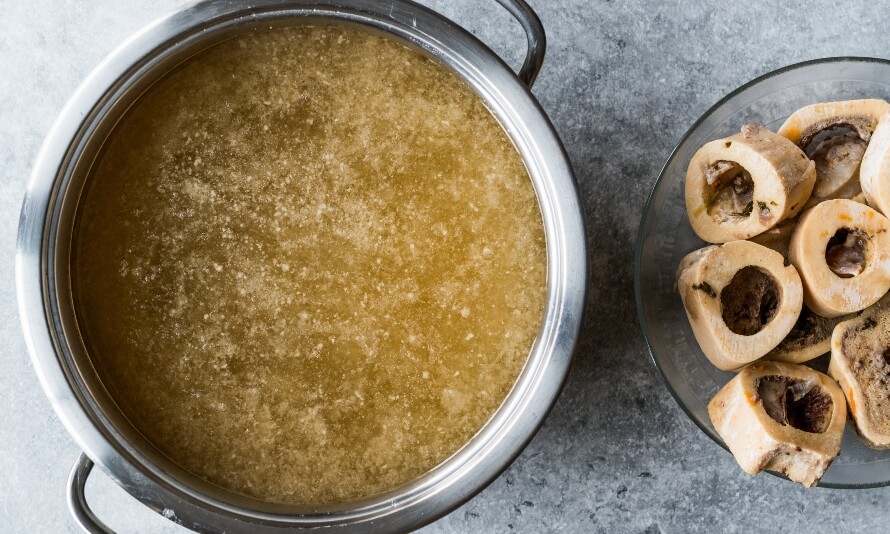The Bone Broth Weight-reduction plan is a weight-loss food regimen created by naturopath Kellyann Petrucci.
It entails following a quasi-paleo food regimen 5 days per week, fasting for the opposite two, and supplementing with bone broth—a brew you make by boiling bones in water for a number of hours.
Proponents of the Bone Broth Weight-reduction plan declare it offers speedy weight reduction, higher well being, and flawless pores and skin.
Detractors say bone broth is nothing greater than a advertising and marketing gewgaw that does little that will help you enhance your physique composition or well being.
Who’s proper?
Be taught the solutions on this article.
What Is the Bone Broth Weight-reduction plan Plan?
The Bone Broth Weight-reduction plan, additionally generally known as “Dr. Kellyann’s Bone Broth Weight-reduction plan” and the “21-Day Bone Broth Weight-reduction plan,” is a food regimen plan created by naturopathic physician Kellyann Petrucci (a naturopathic physician is somebody who makes use of pure treatments to assist the physique heal itself).
In 2015, Petrucci revealed the Bone Broth Weight-reduction plan e-book, detailing a food regimen that promised to assist readers “Lose As much as 15 Kilos, 4 Inches—and Your Wrinkles! In Simply 21 Days.”
The e-book additionally claims that the food regimen can treatment different well being points, together with metabolic and intestine well being issues, systemic irritation, and joint ache.
Discover the Good Dietary supplements for You in Simply 60 Seconds
You do not want dietary supplements to construct muscle, lose fats, and get wholesome. However the proper ones can assist. Take this quiz to study which of them are finest for you.
Take the Quiz
Tips on how to Comply with Dr. Kellyann’s Bone Broth Weight-reduction plan
The Bone Broth Weight-reduction plan is a 21-day food regimen that entails consuming low-carb meals 5 days per week and doing “mini-fasts” on the remaining two days.
In your non-fasting days, your meals primarily encompass meals like meat, fish, eggs, non-starchy greens, and fats.
Between meals, you “snack” on bone broth—a liquor made by boiling animal bones for 12-to-24 hours. In line with Petrucci, this inventory offers your physique with protein, fiber (sure, significantly), amino acids, nutritional vitamins and vitamins, antioxidants, and collagen.
The food regimen prohibits dairy, grains, legumes, added sugar and synthetic sweeteners, processed fruit, refined fats, potatoes (besides candy potatoes), soda, and alcohol. On non-fasting days, Petrucci additionally advises in opposition to monitoring your calorie consumption.
To your “mini-fasts,” which you do on non-consecutive days every week, you possibly can both . . .
- Drink six parts of bone broth, or
- Drink 5 parts of bone broth and eat a night meal of protein, non-starchy greens, and fats.
In each instances, you need to eat not more than 500 energy on mini-fast days.
You’ll be able to proceed with the food regimen after 21 days you probably have extra weight to lose, or you possibly can swap to the “80/20 Upkeep Plan,” which entails consuming solely “accepted” meals 80% of the time and permitting your self extra freedom along with your food regimen for the remaining 20%.
Throughout a upkeep part, you possibly can proceed with mini-fasts or select to cease.
Does the Bone Broth Weight-reduction plan Work?
The Bone Broth Weight-reduction plan and Weight Loss
No scientific research have checked out how efficient the Bone Broth Weight-reduction plan is at serving to you drop some pounds.
Fortuitously, scientists have studied the diets that kind the idea of the Bone Broth Weight-reduction plan—low-carb weight-reduction plan, intermittent fasting, and the paleo food regimen:
- Low-carb weight-reduction plan: Some studies show that low-carb weight-reduction plan is superior to moderate- and high-carb diets for weight reduction, however these research are typically poorly designed. Well–designed studies routinely show that low-carb weight-reduction plan isn’t inherently higher than moderate- and high-carb weight-reduction plan for weight reduction.
- Intermittent fasting: Studies show that intermittent fasting can assist you drop some pounds as a result of it helps you eat fewer energy per day. Nevertheless, it’s no simpler than different types of weight-reduction plan when the variety of energy consumed are the identical. It simply helps some individuals eat much less.
- The paleo food regimen: The paleo food regimen entails consuming a high-protein food regimen that’s wealthy in nutritious fruit and greens and low in processed meals. As such, it helps many people lose weight. That mentioned, it’s additionally restrictive, which suggests some individuals might discover it troublesome to stay to, and there’s no proof it’s superior to a plant-based, high-protein food regimen that additionally incorporates grains, dairy, and different non-paleo meals.
Based mostly on the out there proof, every of those weight-reduction plan methods (or a mix thereof) might assist you to drop some pounds. That mentioned, none of them are important for weight reduction and are possible no simpler than common, calorie-controlled weight-reduction plan.
By and enormous, the explanation The Bone Broth Weight-reduction plan helps individuals drop some pounds is identical as some other food regimen: it restricts how a lot meals you possibly can eat (by limiting meals selections and limiting your calorie consumption on two days per week), which leads to a calorie deficit over time.
(And when you need assistance deciding which food regimen is true on your circumstances and objectives, then take the Legion Weight-reduction plan Quiz! In lower than a minute, it’ll let you know precisely what food regimen is best for you. Click on right here to test it out.)
The Bone Broth Weight-reduction plan and Metabolic Well being
Shedding pounds improves your metabolic well being in some ways, together with serving to you regulate your blood sugar. As such, the Bone Broth Weight-reduction plan could possibly assist.
What’s extra, research shows that low-carb diets are typically higher than low-fat diets for managing sort 2 diabetes, which is one other potential good thing about the Bone Broth Weight-reduction plan.
That mentioned, we’d like extra analysis—notably on the Bone Broth Weight-reduction plan particularly—earlier than we will say that the Bone Broth Weight-reduction plan is a boon for metabolic well being. There’s additionally no purpose to suppose The Bone Broth Weight-reduction plan is superior to different calorie-restricted, whole-foods based mostly diets for this function.
The Bone Broth Weight-reduction plan and Intestine Well being
Collagen incorporates the amino acids proline, glutamine, and glycine.
Some research on rats and some research taking a look at chemotherapy, bone marrow transplant, and Crohn’s disease patients discovered that these amino acids might enhance intestine well being to a small diploma. Different studies on individuals with brief bowel syndrome and different crucial sicknesses, nonetheless, present little to no profit.
Since bone broth incorporates collagen, Petrucci claims that consuming bone broth can assist to enhance your intestine well being. This declare has by no means been verified by analysis.
The Bone Broth Weight-reduction plan and Irritation
Some analysis means that losing weight, eating nutritious meals reminiscent of fruits, greens, and oily fish, and intermittent fasting can cut back systemic irritation.
On these grounds, there’s purpose to imagine that the Bone Broth Weight-reduction plan might cut back irritation, however as but, we now have no analysis to again up this declare.
The Bone Broth Weight-reduction plan and Pores and skin Well being
Among the collagen you consume is damaged down into amino acids, whereas some makes its option to the blood. As soon as there, it will increase the expansion of cells known as fibroblasts and the synthesis of a substance known as hyaluronic acid, each of which assist to take care of your pores and skin and joints.
For this reason research present that collagen dietary supplements can assist to improve skin elasticity and hydration, reduce signs of aging, and increase dermal (pores and skin) blood movement.
As a result of bone broth incorporates collagen, many individuals suppose it’s as efficient as collagen dietary supplements for sustaining optimum pores and skin well being. Nevertheless, research exhibits that home made and commercially out there bone broth incorporates a lot decrease concentrations of collagen than collagen dietary supplements, and thus in all probability isn’t going to do a lot to enhance the looks of your pores and skin.
The Bone Broth Weight-reduction plan and Bone and Joint Well being
Research shows that maintaining a wholesome weight is likely one of the finest methods to maintain your bones and joints wholesome and pain-free. If the Bone Broth Weight-reduction plan helps you drop some pounds, then it could not directly assist enhance your bone and joint well being.
Bone broth additionally incorporates collagen, which can assist to enhance bone mineral density, bone strength, and joint health and function
As a result of we now have no analysis on the Bone Broth Weight-reduction plan, it’s troublesome to say whether or not it has a constructive impact on bone and joint well being, particularly since research exhibits home made and commercially out there bone broth merchandise don’t include sufficient collagen to enhance bone and joint well being.
(If you happen to’d prefer to study which dietary supplements do assist forestall and cut back joint ache, try this text.)
The Bone Broth Weight-reduction plan: Issues
The most important downside with the Bone Broth Weight-reduction plan is that there’s no proof that it really works.
If you happen to take a look at the primary tenets of the food regimen, there’s purpose to imagine that it might assist you to drop some pounds, however hypothesis like this—even when it’s based mostly on an informed studying of the literature—isn’t the identical as empirical proof.
Even when we let this slide (which we undoubtedly shouldn’t), analysis exhibits that a number of the fundamental ideas of the Bone Broth Weight-reduction plan (a mixture of low-carb weight-reduction plan, intermittent fasting, and paleo weight-reduction plan) aren’t any higher than typical types of weight-reduction plan for weight reduction.
And while you weigh this in opposition to the truth that The Bone Broth Weight-reduction plan requires you to chug a number of cups of gelatinous slop per day, eat subsequent to nothing on two days per week, and keep away from many meals that have been shown to confer multiple health benefits, it’s arduous to make a case for this being a wholesome option to eat.
Lastly, and most confusingly, the food regimen is completely based mostly round a drink that guarantees that will help you shed fats, get more healthy, and reverse ageing, but there’s no analysis to point out it’s able to any of this. Quite the opposite, most analysis suggests bone broth is an ineffective well being and weight-loss complement. It is vitally efficient as an overpriced direct-to-consumer product, although, which explains the burgeoning marketplace for ready-to-drink bone broth dietary supplements.
And if the primary USP of the Bone Broth Weight-reduction plan is a busted flush, why the fetish for boiled cow clappers?
It’s unimaginable to say for certain, however the skeptic in me thinks it may need one thing to do with the sum of money that may be made promoting dehydrated bone water. This idea is about as verifiable because the food regimen itself, although.
Within the closing evaluation, the Bone Broth Weight-reduction plan isn’t a magic bullet for weight reduction, higher well being, and longevity. It could assist you to drop some pounds by making it simpler to eat fewer energy than you burn, however this has nothing to do with consuming bone broth.
If you happen to just like the sound of a restrictive, low-carb, paleo-style, intermittent-fasting food regimen that requires you to guzzle greasy cow decoction every day, then the Bone Broth Weight-reduction plan is likely to be price making an attempt.
Or, when you’d desire a extra versatile method to weight-reduction plan that’ll assist you to drop some pounds lickety-split with out dropping muscle or wrestling with extreme starvation, lethargy, and the opposite hobgoblins of low-calorie weight-reduction plan, then observe the recommendation on this article:
Tips on how to Get the Physique You Need With Versatile Weight-reduction plan
FAQ #1: Are there completely different variations of the Bone Broth Weight-reduction plan e-book?
The preferred model of Dr. Kellyann’s Bone Broth Weight-reduction plan is the 21-day Bone Broth Weight-reduction plan, although she additionally has a 10-day Bone Broth Weight-reduction plan e-book, too.
Following Petrucci’s success, different authors have revealed equally flawed books, such because the 7-Day Bone Broth Weight-reduction plan Plan.
FAQ #2: Are Bone Broth Weight-reduction plan earlier than and after footage practical?
They present you what you possibly can obtain when you observe a calorie-controlled food regimen, however they aren’t a sensible illustration of what you possibly can obtain in 21 days following the Bone Broth Weight-reduction plan.
If you happen to test the small print on the Bone Broth Weight-reduction plan outcomes promotional materials, they admit that most individuals lose one-to-two kilos per week, which is about as a lot as you possibly can anticipate on any customary calorie-controlled food regimen.
Additionally they concede that excessive outcomes are atypical, that probably the most placing “after” photographs are the results of greater than 21 days of weight-reduction plan, and that if you wish to keep weight reduction, “train and a correct food regimen are required.”
Thus, it’s in all probability smart to deal with probably the most zealous Bone Broth Weight-reduction plan evaluations with a pinch of salt.
FAQ #3: What’s the perfect bone broth recipe?
Even when you don’t observe the Bone Broth Weight-reduction plan, home made bone broth is a flexible ingredient that provides taste to soups, casseroles, and pasta sauces. Right here’s a easy and engaging bone broth recipe.
(Notice: This recipe just isn’t taken from Dr. Kellyann’s Bone Broth Weight-reduction plan recipes.)
- Preheat the oven to 450 °F.
- Put a mix of beef bones (knucklebones, brief ribs, oxtail, and femur bones) in a big stockpot and canopy with water.
- Place the stockpot over excessive warmth and produce to the boil, then enable to simmer for 10 minutes.
- Drain the bones and rinse with water to scrub any remaining blood and impurities.
- Switch the bones to a roasting tray then wash the massive pot you used for blanching.
- Chop 5 celery stalks, two carrots, two peeled white onions, and 5 peeled garlic cloves into chunks and add them to the roasting tray with the meat bones.
- Place the tray within the preheated oven and roast for Half-hour.
- Take away the tray from the oven and stir the bones and greens, then return to the oven for an additional 15-to-Half-hour.
- Take away the tray from the oven and return its contents to the massive stockpot. Scrape any burn bits on the roasting tray into the stockpot utilizing a wood spatula.
- Add three bay leaves, two star anise, a cinnamon stick, one tablespoon of black peppercorns, and one tablespoon of apple cider vinegar to the pot, then cowl the bones with chilly water and canopy the pan with a tight-fitting lid and produce to the boil.
- As soon as boiling, cut back the warmth to low and with the lid barely ajar, enable to simmer for 10-to-12 hours, skimming any foam or fats as needed.
- Add water as wanted to maintain the bones and greens submerged.
- Pressure the remaining liquid, enable to chill, then retailer in an hermetic container.
+ Scientific References
- Yancy, W. S., Olsen, M. K., Guyton, J. R., Bakst, R. P., & Westman, E. C. (2004). A low-carbohydrate, ketogenic diet versus a low-fat diet to treat obesity and hyperlipidemia: a randomized, controlled trial. Annals of Internal Medicine, 140(10). https://doi.org/10.7326/0003-4819-140-10-200405180-00006
- Volek, J. S., Sharman, M. J., Gómez, A. L., Judelson, D. A., Rubin, M. R., Watson, G., Sokmen, B., Silvestre, R., French, D. N., & Kraemer, W. J. (2004). Comparison of energy-restricted very low-carbohydrate and low-fat diets on weight loss and body composition in overweight men and women. Nutrition & Metabolism, 1, 13. https://doi.org/10.1186/1743-7075-1-13
- Samaha, F. F., Iqbal, N., Seshadri, P., Chicano, K. L., Daily, D. A., McGrory, J., Williams, T., Williams, M., Gracely, E. J., & Stern, L. (2003). A low-carbohydrate as compared with a low-fat diet in severe obesity. The New England Journal of Medicine, 348(21), 2074–2081. https://doi.org/10.1056/NEJMOA022637
- Johnston, C. S., Tjonn, S. L., Swan, P. D., White, A., Hutchins, H., & Sears, B. (2006). Ketogenic low-carbohydrate diets have no metabolic advantage over nonketogenic low-carbohydrate diets. The American Journal of Clinical Nutrition, 83(5), 1055–1061. https://doi.org/10.1093/AJCN/83.5.1055
- Phillips, S. A., Jurva, J. W., Syed, A. Q., Syed, A. Q., Kulinski, J. P., Pleuss, J., Hoffmann, R. G., & Gutterman, D. D. (2008). Benefit of low-fat over low-carbohydrate diet on endothelial health in obesity. Hypertension (Dallas, Tex. : 1979), 51(2), 376–382. https://doi.org/10.1161/HYPERTENSIONAHA.107.101824
- Sacks, F. M., Bray, G. A., Carey, V. J., Smith, S. R., Ryan, D. H., Anton, S. D., McManus, K., Champagne, C. M., Bishop, L. M., Laranjo, N., Leboff, M. S., Rood, J. C., de Jonge, L., Greenway, F. L., Loria, C. M., Obarzanek, E., & Williamson, D. A. (2009). Comparison of weight-loss diets with different compositions of fat, protein, and carbohydrates. The New England Journal of Medicine, 360(9), 859–873. https://doi.org/10.1056/NEJMOA0804748
- Thomson, C. A., Stopeck, A. T., Bea, J. W., Cussler, E., Nardi, E., Frey, G., & Thompson, P. A. (2010). Changes in body weight and metabolic indexes in overweight breast cancer survivors enrolled in a randomized trial of low-fat vs. reduced carbohydrate diets. Nutrition and Cancer, 62(8), 1142–1152. https://doi.org/10.1080/01635581.2010.513803
- Churuangsuk, C., Kherouf, M., Combet, E., & Lean, M. (2018). Low-carbohydrate diets for overweight and obesity: a systematic review of the systematic reviews. Obesity Reviews : An Official Journal of the International Association for the Study of Obesity, 19(12), 1700–1718. https://doi.org/10.1111/OBR.12744
- Rynders, C. A., Thomas, E. A., Zaman, A., Pan, Z., Catenacci, V. A., & Melanson, E. L. (2019). Effectiveness of Intermittent Fasting and Time-Restricted Feeding Compared to Continuous Energy Restriction for Weight Loss. Nutrients, 11(10). https://doi.org/10.3390/NU11102442
- Nowosad, K., & Sujka, M. (2021). Effect of Various Types of Intermittent Fasting (IF) on Weight Loss and Improvement of Diabetic Parameters in Human. Current Nutrition Reports, 10(2), 146–154. https://doi.org/10.1007/S13668-021-00353-5/TABLES/3
- Sainsbury, A., Wood, R. E., Seimon, R. V., Hills, A. P., King, N. A., Gibson, A. A., & Byrne, N. M. (2018). Rationale for novel intermittent dieting strategies to attenuate adaptive responses to energy restriction. Obesity Reviews : An Official Journal of the International Association for the Study of Obesity, 19 Suppl 1, 47–60. https://doi.org/10.1111/OBR.12787
- Varady, K. A., Cienfuegos, S., Ezpeleta, M., & Gabel, K. (2021). Cardiometabolic Benefits of Intermittent Fasting. Https://Doi.Org/10.1146/Annurev-Nutr-052020-041327, 41, 333–361. https://doi.org/10.1146/ANNUREV-NUTR-052020-041327
- Mellberg, C., Sandberg, S., Ryberg, M., Eriksson, M., Brage, S., Larsson, C., Olsson, T., & Lindahl, B. (2014). Long-term effects of a Palaeolithic-type diet in obese postmenopausal women: a two-year randomized trial. European Journal of Clinical Nutrition, 68(3), 350. https://doi.org/10.1038/EJCN.2013.290
- De Menezes, E. V. A., Sampaio, H. A. D. C., Carioca, A. A. F., Parente, N. A., Brito, F. O., Moreira, T. M. M., De Souza, A. C. C., & Arruda, S. P. M. H. (2019). Influence of Paleolithic diet on anthropometric markers in chronic diseases: systematic review and meta-analysis. Nutrition Journal, 18(1). https://doi.org/10.1186/S12937-019-0457-Z
- Frassetto, L. A., Schloetter, M., Mietus-Synder, M., Morris, R. C., & Sebastian, A. (2009). Metabolic and physiologic improvements from consuming a paleolithic, hunter-gatherer type diet. European Journal of Clinical Nutrition, 63(8), 947–955. https://doi.org/10.1038/EJCN.2009.4
- Lindeberg, S., Jönsson, T., Granfeldt, Y., Borgstrand, E., Soffman, J., Sjöström, K., & Ahrén, B. (2007). A Palaeolithic diet improves glucose tolerance more than a Mediterranean-like diet in individuals with ischaemic heart disease. Diabetologia, 50(9), 1795–1807. https://doi.org/10.1007/S00125-007-0716-Y
- Han, T. S., & Lean, M. E. (2016). A clinical perspective of obesity, metabolic syndrome and cardiovascular disease. JRSM Cardiovascular Disease, 5, 204800401663337. https://doi.org/10.1177/2048004016633371
- Hamdy, O., Tasabehji, M. W., Elseaidy, T., Tomah, S., Ashrafzadeh, S., & Mottalib, A. (2018). Fat Versus Carbohydrate-Based Energy-Restricted Diets for Weight Loss in Patients With Type 2 Diabetes. Current Diabetes Reports, 18(12). https://doi.org/10.1007/S11892-018-1103-4
- Huntriss, R., Campbell, M., & Bedwell, C. (2018). The interpretation and effect of a low-carbohydrate diet in the management of type 2 diabetes: a systematic review and meta-analysis of randomised controlled trials. European Journal of Clinical Nutrition, 72(3), 311–325. https://doi.org/10.1038/S41430-017-0019-4
- Tay, J., Thompson, C. H., Luscombe-Marsh, N. D., Wycherley, T. P., Noakes, M., Buckley, J. D., Wittert, G. A., Yancy, W. S., & Brinkworth, G. D. (2018). Effects of an energy-restricted low-carbohydrate, high unsaturated fat/low saturated fat diet versus a high-carbohydrate, low-fat diet in type 2 diabetes: A 2-year randomized clinical trial. Diabetes, Obesity & Metabolism, 20(4), 858–871. https://doi.org/10.1111/DOM.13164
- Samonina, G., Lyapina, L., Kopylova, G., Pastorova, V., Bakaeva, Z., Jeliaznik, N., Zuykova, S., & Ashmarin, I. (2000). Protection of gastric mucosal integrity by gelatin and simple proline-containing peptides. Pathophysiology : The Official Journal of the International Society for Pathophysiology, 7(1), 69–73. https://doi.org/10.1016/S0928-4680(00)00045-6
- Kim, H. (2011). Glutamine as an immunonutrient. Yonsei Medical Journal, 52(6), 892–897. https://doi.org/10.3349/YMJ.2011.52.6.892
- Howard, A., & Hirst, B. H. (2011). The glycine transporter GLYT1 in human intestine: expression and function. Biological & Pharmaceutical Bulletin, 34(6), 784–788. https://doi.org/10.1248/BPB.34.784
- Skubitz, K. M., & Anderson, P. M. (1996). Oral glutamine to prevent chemotherapy induced stomatitis: A pilot study. Journal of Laboratory and Clinical Medicine, 127(2), 223–228. https://doi.org/10.1016/S0022-2143(96)90082-7
- Schloerb, P. R., & Skikne, B. S. (1999). Oral and parenteral glutamine in bone marrow transplantation: a randomized, double-blind study. JPEN. Journal of Parenteral and Enteral Nutrition, 23(3), 117–122. https://doi.org/10.1177/0148607199023003117
- Den Hond, E., Hiele, M., Peeters, M., Ghoos, Y., & Rutgeerts, P. (1999). Effect of long-term oral glutamine supplements on small intestinal permeability in patients with Crohn’s disease. JPEN. Journal of Parenteral and Enteral Nutrition, 23(1), 7–11. https://doi.org/10.1177/014860719902300107
- Grimble, R. F. (2005). Immunonutrition. Current Opinion in Gastroenterology, 21(2), 216–222. https://doi.org/10.1097/01.MOG.0000153360.90653.82
- Sung, J., Ho, C. T., & Wang, Y. (2018). Preventive mechanism of bioactive dietary foods on obesity-related inflammation and diseases. Food & Function, 9(12), 6081–6095. https://doi.org/10.1039/C8FO01561A
- Bustamante, M. F., Agustín-Perez, M., Cedola, F., Coras, R., Narasimhan, R., Golshan, S., & Guma, M. (2020). Design of an anti-inflammatory diet (ITIS diet) for patients with rheumatoid arthritis. Contemporary Clinical Trials Communications, 17, 100524. https://doi.org/10.1016/J.CONCTC.2020.100524
- Shivappa, N., Steck, S. E., Hurley, T. G., Hussey, J. R., & Hébert, J. R. (2014). Designing and developing a literature-derived, population-based dietary inflammatory index. Public Health Nutrition, 17(8), 1689–1696. https://doi.org/10.1017/S1368980013002115
- Patterson, R. E., & Sears, D. D. (2017). Metabolic Effects of Intermittent Fasting. Annual Review of Nutrition, 37, 371–393. https://doi.org/10.1146/ANNUREV-NUTR-071816-064634
- Faris, M. A. I. E., Kacimi, S., Al-Kurd, R. A., Fararjeh, M. A., Bustanji, Y. K., Mohammad, M. K., & Salem, M. L. (2012). Intermittent fasting during Ramadan attenuates proinflammatory cytokines and immune cells in healthy subjects. Nutrition Research (New York, N.Y.), 32(12), 947–955. https://doi.org/10.1016/J.NUTRES.2012.06.021
- Sato, K. (2017). The presence of food-derived collagen peptides in human body-structure and biological activity. Food & Function, 8(12), 4325–4330. https://doi.org/10.1039/C7FO01275F
- Proksch, E., Segger, D., Degwert, J., Schunck, M., Zague, V., & Oesser, S. (2014). Oral supplementation of specific collagen peptides has beneficial effects on human skin physiology: a double-blind, placebo-controlled study. Skin Pharmacology and Physiology, 27(1), 47–55. https://doi.org/10.1159/000351376
- Asserin, J., Lati, E., Shioya, T., & Prawitt, J. (2015). The effect of oral collagen peptide supplementation on skin moisture and the dermal collagen network: evidence from an ex vivo model and randomized, placebo-controlled clinical trials. Journal of Cosmetic Dermatology, 14(4), 291–301. https://doi.org/10.1111/JOCD.12174
- Genovese, L., Corbo, A., & Sibilla, S. (2017). An Insight into the Changes in Skin Texture and Properties following Dietary Intervention with a Nutricosmeceutical Containing a Blend of Collagen Bioactive Peptides and Antioxidants. Skin Pharmacology and Physiology, 30(3), 146–158. https://doi.org/10.1159/000464470
- de Miranda, R. B., Weimer, P., & Rossi, R. C. (2021). Effects of hydrolyzed collagen supplementation on skin aging: a systematic review and meta-analysis. International Journal of Dermatology, 60(12), 1449–1461. https://doi.org/10.1111/IJD.15518
- Schwartz, S. R., & Park, J. (2012). Ingestion of BioCell Collagen(®), a novel hydrolyzed chicken sternal cartilage extract; enhanced blood microcirculation and reduced facial aging signs. Clinical Interventions in Aging, 7, 267–273. https://doi.org/10.2147/CIA.S32836
- Alcock, R. D., Shaw, G. C., & Burke, L. M. (2019). Bone Broth Unlikely to Provide Reliable Concentrations of Collagen Precursors Compared With Supplemental Sources of Collagen Used in Collagen Research. International Journal of Sport Nutrition and Exercise Metabolism, 29(3), 265–272. https://doi.org/10.1123/IJSNEM.2018-0139
- King, L. K., March, L., & Anandacoomarasamy, A. (2013). Obesity & osteoarthritis. The Indian Journal of Medical Research, 138(2), 185. /pmc/articles/PMC3788203/
- Raud, B., Gay, C., Guiguet-Auclair, C., Bonnin, A., Gerbaud, L., Pereira, B., Duclos, M., Boirie, Y., & Coudeyre, E. (2020). Level of obesity is directly associated with the clinical and functional consequences of knee osteoarthritis. Scientific Reports 2020 10:1, 10(1), 1–7. https://doi.org/10.1038/s41598-020-60587-1
- Wang, T., & He, C. (2018). Pro-inflammatory cytokines: The link between obesity and osteoarthritis. Cytokine & Growth Factor Reviews, 44, 38–50. https://doi.org/10.1016/J.CYTOGFR.2018.10.002
- König, D., Oesser, S., Scharla, S., Zdzieblik, D., & Gollhofer, A. (2018). Specific Collagen Peptides Improve Bone Mineral Density and Bone Markers in Postmenopausal Women—A Randomized Controlled Study. Nutrients, 10(1). https://doi.org/10.3390/NU10010097
- Viguet-Carrin, S., Garnero, P., & Delmas, P. D. (2006). The role of collagen in bone strength. Osteoporosis International : A Journal Established as Result of Cooperation between the European Foundation for Osteoporosis and the National Osteoporosis Foundation of the USA, 17(3), 319–336. https://doi.org/10.1007/S00198-005-2035-9
- Kumar, S., Sugihara, F., Suzuki, K., Inoue, N., & Venkateswarathirukumara, S. (2015). A double-blind, placebo-controlled, randomised, clinical study on the effectiveness of collagen peptide on osteoarthritis. Journal of the Science of Food and Agriculture, 95(4), 702–707. https://doi.org/10.1002/JSFA.6752
- Zdzieblik, D., Oesser, S., Gollhofer, A., & König, D. (2017). Improvement of activity-related knee joint discomfort following supplementation of specific collagen peptides. Applied Physiology, Nutrition, and Metabolism = Physiologie Appliquee, Nutrition et Metabolisme, 42(6), 588–595. https://doi.org/10.1139/APNM-2016-0390
- Lugo, J. P., Saiyed, Z. M., & Lane, N. E. (2016). Efficacy and tolerability of an undenatured type II collagen supplement in modulating knee osteoarthritis symptoms: A multicenter randomized, double-blind, placebo-controlled study. Nutrition Journal, 15(1), 1–15. https://doi.org/10.1186/S12937-016-0130-8/TABLES/10
- Crowley, D. C., Lau, F. C., Sharma, P., Evans, M., Guthrie, N., Bagchi, M., Bagchi, D., Dey, D. K., & Raychaudhuri, S. P. (2009). Safety and efficacy of undenatured type II collagen in the treatment of osteoarthritis of the knee: a clinical trial. International Journal of Medical Sciences, 6(6), 312. https://doi.org/10.7150/IJMS.6.312
- Bazzano, L. A., Thompson, A. M., Tees, M. T., Nguyen, C. H., & Winham, D. M. (2011). Non-soy legume consumption lowers cholesterol levels: a meta-analysis of randomized controlled trials. Nutrition, Metabolism, and Cardiovascular Diseases : NMCD, 21(2), 94–103. https://doi.org/10.1016/J.NUMECD.2009.08.012
- Josse, A. R., Tang, J. E., Tarnopolsky, M. A., & Phillips, S. M. (2010). Body composition and strength changes in women with milk and resistance exercise. Medicine and Science in Sports and Exercise, 42(6), 1122–1130. https://doi.org/10.1249/MSS.0B013E3181C854F6
- Heaney, R. P. (2009). Dairy and bone health. Journal of the American College of Nutrition, 28 Suppl 1, 82S-90S. https://doi.org/10.1080/07315724.2009.10719808
- Masters, R. C., Liese, A. D., Haffner, S. M., Wagenknecht, L. E., & Hanley, A. J. (2010). Whole and refined grain intakes are related to inflammatory protein concentrations in human plasma. The Journal of Nutrition, 140(3), 587–594. https://doi.org/10.3945/JN.109.116640
- Katcher, H. I., Legro, R. S., Kunselman, A. R., Gillies, P. J., Demers, L. M., Bagshaw, D. M., & Kris-Etherton, P. M. (2008). The effects of a whole grain-enriched hypocaloric diet on cardiovascular disease risk factors in men and women with metabolic syndrome. The American Journal of Clinical Nutrition, 87(1), 79–90. https://doi.org/10.1093/AJCN/87.1.79
- De Munter, J. S. L., Hu, F. B., Spiegelman, D., Franz, M., & Van Dam, R. M. (2007). Whole grain, bran, and germ intake and risk of type 2 diabetes: a prospective cohort study and systematic review. PLoS Medicine, 4(8), 1385–1395. https://doi.org/10.1371/JOURNAL.PMED.0040261
- Jacobs, D. R., Marquart, L., Slavin, J., & Kushi, L. H. (1998). Whole-grain intake and cancer: an expanded review and meta-analysis. Nutrition and Cancer, 30(2), 85–96. https://doi.org/10.1080/01635589809514647
- Jacobs, D. R., Andersen, L. F., & Blomhoff, R. (2007). Whole-grain consumption is associated with a reduced risk of noncardiovascular, noncancer death attributed to inflammatory diseases in the Iowa Women’s Health Study. The American Journal of Clinical Nutrition, 85(6), 1606–1614. https://doi.org/10.1093/AJCN/85.6.1606












